#Proto-renaissance
Text

The Seven Virtues: Faith, Giotto, 1306
#art#art history#Giotto#Giotto di Bondone#fresco#religious art#Christian art#Christianity#Catholicism#allegory#allegorical art#faith#seven virtues#Trecento#Middle Ages#medieval#medieval art#Gothic art#International Gothic#Italian Gothic#Proto-Renaissance#Italian art#14th century art#Scrovegni Chapel
119 notes
·
View notes
Photo

Detail
Giovanni del Biondo, Martyrdom of St Sebastian, circa 1375-1380
Paint on wood
https://en.wikipedia.org/wiki/Giovanni_del_Biondo
#hannibal#nbc hannibal#art that reminds me of hannibal#Giovanni del Biondo#paintings and mostly 2d art#14th century art#gothic painting#proto renaissance#saint vibes#st sebastian and st sebastian adjacent#human(ish) bodies#queue
76 notes
·
View notes
Text
Aight
send me a picture of anything that you think is a “Renaissance painting”
Like that picture of all those people at a baseball game dodging a ball
Or your cats engaged in battle
I will use my art history degree to analyze the composition of the picture and tell you in detail why or why not I think it resembles a Renaissance painting.
#I already did the pic of the roommates finding out destile is cannon#spoiler IT IS#I studied the proto Renaissance#the Italian high Renaissance#and the northern Renaissance#bruh I just want people to understand the term “’Renaissance”’ when referring to the art of the Italian Renaissance#is not as broad as people on here seem to think#I’m doing this on my art blog not my main Bc idk how many people give a shit#fuck I’ll even tell you what artist I think would do it justice#if I wasn’t so burnt out I’d even probably try to paint them in the style of a particular artist but nah that’s effort
101 notes
·
View notes
Text
WIP Game
thank you @the-eldritch-it-gay for tagging me!!!! 💕💕💕
RULES: post the names of all the files in your WIP list, regardless of how non-descriptive or ridiculous. Let people send an ask with the title that most intrigues them and then post a little snippet or tell them something about it. And then tag as many people as you have WIPs.
This is where I admit I keep most of my WIPs in one Google doc and don't title them unless there's a decent chance I'm going to post it to Ao3 one day, so I'm going to cheat a wee bit and share both general file names & titles for things that have them.
And um I'm very bad at tagging folks, but if you're working on something, consider yourself tagged!
bg3 cyrus fics
How to Tend the Bloodless
cyrusXvarric quarantine zone
cyrus renaissance
Coda
Praeludium
#fun fact 'cyrus renaissance' is a rebrand of my original cyrus doc#from (and this shocked me as well)#TWENTY FUCKING SIXTEEN#i really had cyrus pegged as a 2018 oc i cannot beLIEVE he has been with me (even in proto form) for so long...
2 notes
·
View notes
Text
Native
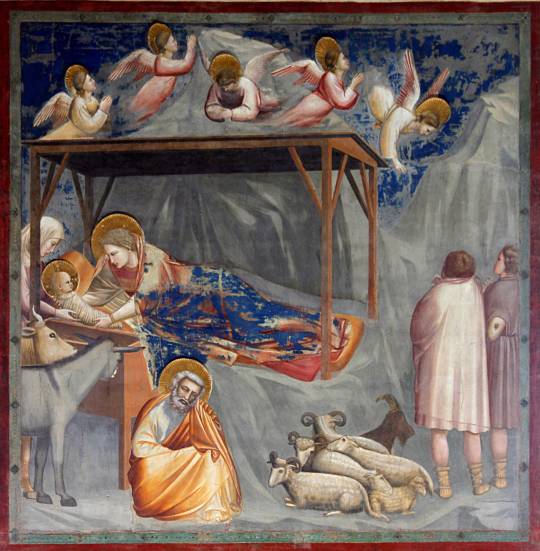
-Giotto di Bondone,1303-1305
3 notes
·
View notes
Text

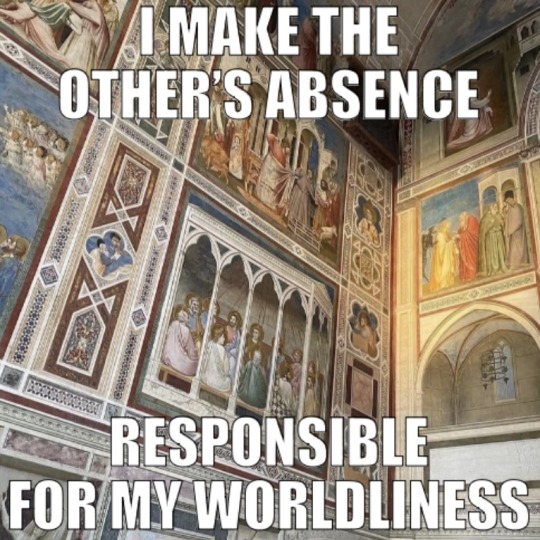

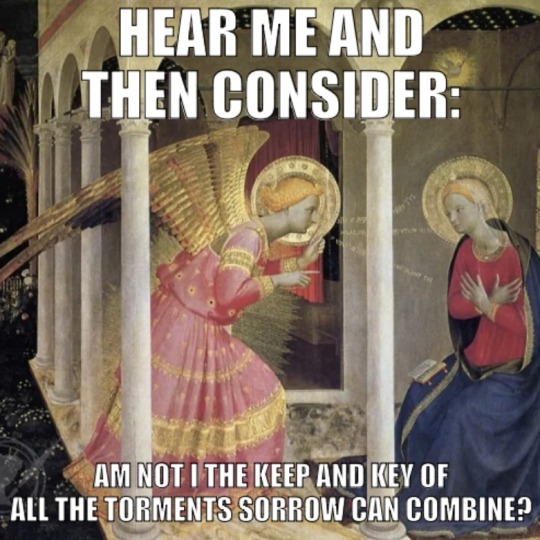
#roland barthes#dante#giotto#frescoes#proto renaissance#fra angelico#Casa dei Casti Amanti#House of Meleager#semiotics
0 notes
Text
One thing I love about Crowley --never stated, but consistently shown-- is that he is, at heart, an engineer.
I have a few different things to say about that. Let's unpack them.
As the Unnamed Angel, we see his designs for the Pillars of Creation are millions of pages long, comprised of cramped text, footnotes, diagrams, schematics, etc. It's very...Renaissance polymath, in the way it implies a particular intersection of artist and inventor.
Also: in the naked romanticism with which he views his stars.
We already knew he made stars, but in s2 we learn that he did NOT sculpt each of them by hand. He designed a nebula ("a star factory," he says) that will form several thousand young stars and proto-planets, and all --aside from getting the 'factory' running-- without him lifting a finger. We also learn that these young stars and proto-planets stand in contrast to those made by other angels, which are going to come 'pre-aged.'
...I'm reminded of Hastur and Ligur's approach to temptations. Damning one human soul at a time, devoting singular attention to it over the course of years or decades, and how that stands in contrast to Crowley's reliance on, quote, 'knock-on effects.'
Ligur: It's not exactly...craftsmanship.
Crowley: Head office don't seem to mind. They love me down there.
Hm.
I'm also reminded of the M25.
The M25 may not be as grand as a nebula (sentences you only say in GOmens fandom...), but LIKE his nebula it's an intricate, self-sustaining engine that does Crowley's work for him, many times over. Again.
That's some pretty neat characterization --and so is the indication towards Crowley's disinterest in victimizing anyone tempting individual people. It takes a considerable amount of planning and effort (and creeping about in wellies), but in accordance with his design the M25 generates a constant stream of low-grade evil on a gigantic scale.
Cumulatively gigantic, that is. Individually? Negligible.
But no other demon understands human nature well enough to parse that one million ticked-off motorists are not, in any meaningful way, actually equivalent to one dictator, or one mass-murderer, or even one little influential regressive. That's the trick of it. Crowley gets Hell's approval (which he NEEDS to survive, and to maintain the degree of freedom he's eked out for himself), and at the same time ensures that any actual ~Evil Influence~ is spread nice and thin.
It's some clever machinery. And he knows it, too:
The Unnamed Angel and Crowley are both proud of their ideas.
(musings on professional pride, Leonardo da Vinci, the crank handle, and 'the point to which Crowley loves Aziraphale' under the cut)
In the 1970's Crowley gives a presentation on the M25, projector and all, to a room full of increasingly impatient demons. Maybe the presentation was work-ordered; the 'can I hear a WAHOO?' definitely wasn't.
Before the Beginning, the Unnamed Angel can barely contain his excitement about his nebula. Aziraphale manages a baffled-but-polite, "....That's nice... :)"
11 years ago, Hastur and Ligur want to 'tell the deeds of the day,' and Crowley smiles to himself because (according to the script-book) he knows he has 'the best one.'
(Naturally, his 'deed' has nothing to do with tempting anybody, and everything to do with setting up a human-powered Rube-Goldberg machine of petty annoyance. Oodles of 'Evil' generated; very little harm done.)
Hastur and Ligur don't get it, of course. That's also consistent.
Nobody ever knows what the hell he's talking about.
It didn't make it on-screen, but, in both the novel AND the script-book, Crowley was friends with Leonardo da Vinci. The quintessential Renaissance polymath. That's where he got his drawing of the Mona Lisa --they're getting very drunk together, and Crowley picks up the 'most beautiful' of the preliminary sketches. He wants to buy it. Leonardo agrees almost off-the-cuff, very casual, because they're friends, and because he has bigger fish to fry than haggling over a doodle:
He goes, "Now, explain this helicopter thingie again, will you?" Because he's an engineer, too.
(It is 1519 at the latest, in this scene. Why the FUCK would Crowley know about helicopters, and be able to explain them, comprehensively, to Leonardo da Vinci?
...Well. I choose to believe he got bored one day and worked it out. Look, if you know how to build a nebula, you can probably handle aerodynamics. And anyway, I think it's telling that this is his idea of shooting the shit. 'A drunken mind speaks a sober heart,' and all. He probably babbled about Aziraphale long enough to make poor Leo sick)
Apart from Aziraphale, Leonardo da Vinci is the only person Crowley has any keepsakes or mementos of.
Think about that, though. Aziraphale's bookshop is bursting with letters, paintings, busts, and personalized signatures memorializing all the humans he's known and befriended over 6000 years (indeed: Aziraphale has living human friends up and down Whickber Street. He's part of a community).
Crowley doesn't have any of that. It's just the stone albatross from the Church (for pining), the infamous gay sex statue (for spicy pining), the houseplants (for roleplaying his deepest trauma over and over, as one does), and this one piece of artwork, inscribed, "To my friend Anthony from your friend Leo da V."
To me, at least, that suggests a level of attachment that seems to be rare for Crowley.
...Maybe he liked having someone to talk shop with? Someone who was interested? Someone engaged enough to ask questions when they didn't immediately understand?
...Anyway.
There's also the matter of the crank handle.
This thing:

This is one of the subtler changes from the book. In the book, Crowley knows Satan is coming and, desperate, arms himself with a tire iron. It's the best he can do. He's not Aziraphale; he wasn't made to wield a flaming sword.
The show, IMO, improves on this considerably. Now he, like Aziraphale, gets to face annihilation with what he was made for in his hand. And it's not a weapon, not even an improvised one like the tire iron.
He made stars with it.

[both gifs by @fuckyeahgoodomens]
If you Google 'crank handle,' you'll get variations on this:
Crank handles have been around for centuries. Consisting of a mechanical arm that's connected to a perpendicular rotating shaft, they are designed to convert circular motion into rotary or reciprocating motion.
Which is to say they're one of the 'simple machines,' like a lever or a pulley; the bread and butter of engineering. You'll also get a list of uses for a crank handle, archaic and modern. Among them: cranking up the engine of an old-fashioned car... say, a 1933 Bentley. That's what Crowley has been using his for, lately. But he's had it since he was an angel and he's still, it seems, very capable of it's angelic applications.
Stopping time. For instance.
(This is conjecture on my part, but, I like to imagine that Crowley has the ability to stop time for the same reason I can --and should-- unplug my computer before I perform maintenance on it. Time and Space are a matched set, after all, and in his designs in particular, one feeds into the other.)
I know everyone has already said this, but: I REALLY LIKE that when he needs to channel the heights of his power, he does so not with a weapon but with a tool. Practically with a little handheld metaphor for ingenuity. One from long-lost days when he made beautiful things.
(And he loved it. Still loves it --he incorporated that metaphor into the Bentley, didn't he?)
Let Aziraphale rock up to the apocalypse with a weapon: he has his own compelling thematic reasons to do exactly that. Crowley's story is different, and fighting isn't the only way to express defiance. And if you've been condemned as a demon and assumed to be destructive by your very nature, what better way than this?
He made stars. They didn't manage to take that from him.
Neither Crowley nor Aziraphale are fighters, really --they have no intention of fighting in any war. They'll annoy everyone until there's no war to fight in, for a start. But between the two, if one must be, then that one is Aziraphale. Principality of the Earth, Guardian of the Eastern Gate, Wielder of the Flaming Sword... all that stuff. Even if he'd prefer not to, it's very clear that Aziraphale can rise to the occasion, if he must.
Crowley was never that kind of angel. He wasn't a Principality. He doesn't have a sword.
...And yet.
It's Crowley who protects. He's the one who paces, who stands guard, who circles Aziraphale and glares out at the world, just daring anyone else to come near.
In light of everything else I've said here, I think that's interesting.
Obviously part of it is that Aziraphale enjoys it and, you know, good for him. He's living his best life, no doubt no doubt no doubt. But what about Crowley? What's driving that behavior, really?
Have you heard the phrase, 'loved to the point of invention'? Well, what if 'the point of invention' was where you started? What if where you end up involves glaring out at the world, just daring anyone else to come near? What is that, in relation to the bright-eyed thing you used to be?
What do we name the point to which Crowley loves Aziraphale?
...Thinking about how an excitable angel with three million pages of star design he wants to tell you all about...becomes a guard dog. Is all.
#good omens#ineffable husbands#aziracrow#Crowley#Aziraphale#good omens 2#good omens meta#unfortunately I do not have trains of thought#only long meandering strolls of thought#sorry about it#anyway tl;dr Crowley is a nerd#also I have a strange emotional attachment to the idea of 1500's Crowley...#...facedown in a pile of Mona Lisa sketches; drunkenly info-dumping about Aziraphale#and Da Vinci is just like. 'Ahhhh mio amico Antonio. You fucking simp.'
10K notes
·
View notes
Text

Traveling.
1 note
·
View note
Text

Making an ita bag so doodled the bards to print out for a cute lil pin badge
ALSO!!! never posted the full piece I made for Palimpsest. here it is!! proto-renaissance bard content be upon ye

#pentiment#alexander rappolt#kazimierz wierzbięta#the pose on the pin badge is refed from pinterest bc i cant be bothered to use my brain#im just here to make a yaoi ita bag man#my art
86 notes
·
View notes
Text
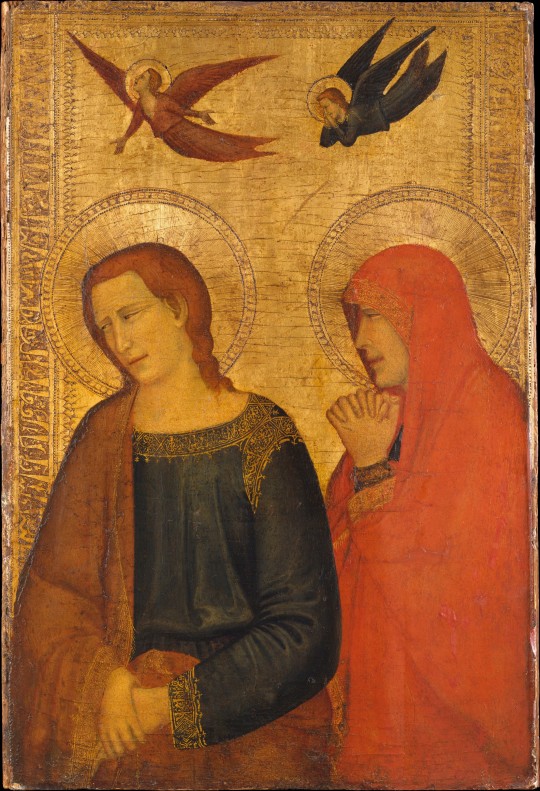
Saints John the Evangelist and Mary Magdalene, follower of Giotto, ca. 1335-45
#art#art history#Middle Ages#medieval#medieval art#religious art#Christian art#Christianity#Catholicism#John the Evangelist#Mary Magdalene#Proto-Renaissance#Trecento#Italian art#14th century art#tempera on wood#Metropolitan Museum of Art
135 notes
·
View notes
Text

this is so funny to me because the exact opposite is true. firstly, nobody in Florence was having gay sex after Savonarola, especially not as devout as Michelangelo. second, he was OBSESSED with breastmilk and credited all his success to having a wetnurse from a stonemason family.
in the renaissance, they explained why women don't menstruate while breastfeeding with the belief that breastmilk was literally menstrual blood that would get purified up to the breasts through the mysterious uterine "tubes" so wetnurses all needed to be morally "good" and were given credit for how successful or skilled someone was. which is crazy progressive for such a misogynist period which insisted women didn't contribute at all to the creation of people, due to following proto-scientific Aristotelian ideas of "biology"
one of his earliest works was madonna of the stairs at about 15... weird sarcophagus composition and awkward proportions. but its the only work he never sold and kept it with him his entire life

36 notes
·
View notes
Text
Vampires before they were cool... (1)
Before talking about Dracula, before talking about the first vampire in literature, why don’t we talk about the first vampires in beliefs and folklore?
Everybody is convinced that they know what vampires are. And yet they don’t. People were so influenced by the literary and then cinematic depiction of the vampire as the undead seducer, as the demonic aristocrat, as the tortured soul who just looks like a human with some pointy teeth… They forgot what vampires started out as, and the “original” vampire is. Which is actually something quite close to the modern idea of what a “zombie” is today – with some elements of evil ghosts and murderous wraiths thrown in. A ghostly zombie, how cool is that?
Let’s start at the beginning of it all (and maybe we’ll even go before the beginnings): when did the figure of the vampire per-se appeared in Europe? (I won’t talk here of all the proto-vampires and all the beliefs that led to the apparition of the vampire, I’ll keep this for another time).
[Also just to specify, again, because people are going to raise their fingers: this is by no mean an extensive, well-researched, definitive scholarly work. I'm just scribbling notes here and there in case people didn't heard about this stuff or wish to discover new roads to explore]

As I am using the chronology established by Jean Marigny, I will begin with the 11th century. It was in this era that the first rumors about dead people whose corpse was repeatedly found outside of their grave, and untouched by rot, started spreading around. The bishop of Cahors shared a story in 1031, during the second Council of Limoges (it was later relayed by Collin de Plancy in his “Dictionnaire infernal”): according to him, a knight of his congregation who had been excommunicated before dying had his body found several times outside of his grave, as if he kept coming out of it. The blood-sucking or “life-stealing” element would come later: a mix of old “paganism” from the Norse and Celtic beliefs, and of the superstitions of medieval Christianity, the image of the vampire as we would know it today first truly appeared in the British Isles, in Iceland, and in other Scandinavian countries. As early as the 12th century, we find in England stories of dead people (usually excommunicated) who each night leave their grave to either torment their loved ones, or cause a series of unusual deaths. When upon investigation the graves of the deceased were opened, their corpse was found unrotten and covered in blood – to end the “curse”, people usually burned the corpse after piercing it with a sword. Tales of the sort can be found in works such as “De Nugis Curialium” (1193) by Walter Map, or the “Historia Regis Anglicarum” (1196) by William of Newburgh. Since there was no real terminology or word for these creatures, the chronicles usually described them as “cadaver sanguisugus”.

These early cases of vampirism were a recurring thing throughout the following centuries – similar stories can be found all the way up to the Renaissance, though they were usually so episodic and isolated that they did not leave a lasting impact on cultures or beliefs.
It would only be by the 14th century that vampirism would start to exist as an “epidemic” – with manifestations of mass phenomenon in areas such as Bohemia, Silesia or Eastern Prussia. This generalization of vampires, and the sudden “spectacular” nature of their manifestations, is easy to explain: it all coincides with the great plagues epidemics. It was well known that, out of fear of contagion, the dead were very quickly and hastily buried – sometimes before they were even dead… Just being sick and disease enough could lead you to get six feet underground. Of course, as a result, if the graves or vaults were opened a few days later, one would find the body untouched by rot but covered in blood – as the poor people probably tried to claw their way out, or actually died after their burial. These grizzly tragedies, in a 16th century filled with superstitions and tormented by many diseases, resulted in a true boom of the vampire belief. An interesting case showing how even the upper-class of society could not escape is the one of the Prussian baron Steino of Retten. After dying of the plague, he was buried in grandiose funerals with all the honors due to his rank… But the following days, many people claimed to have seen the baron outside of his graves, walking around as if he was still alive. This led to the baron’s grave being opened, and his body pierced many times with a sword to “allow his soul to go to rest”. Numerous similar cases were reported in Bohemia around the same time.

In Western Europe, meanwhile, vampire cases stayed sporadic and episodic… Until 1484. On 1484, the pope Innocent VIII approved the publication of the “Malleus Maleficarum” – while most known as the “witch-hunter manual” which turned the medieval persecutions into an absolute horror, this book by the Dominicans Jakob Sprenger and Heinrich Kramer (who notably got into a lot of troubles and fighting with authorities of the Church precisely due to some of the beliefs in this book contradicting the Church teachings) was also an investigation and study of cases of succubus, incubus and undead. When it was said and shared around Europe that the pope had accepted and “sponsored”, so to speak, this book, it was a HUGE wave of shock with lasting effects: it meant the Church was officially recognizing the existence of the undead…
Then, the Reformation would too strengthen the legend of the vampire, during the second half of the 16th century. You see, there was a belief going around (and born during the times of the great plague) that the dead in their graves would devour themselves, as things looking like bite marks or self-devouring appeared on corpses dug out after their burial (again, very likely result of hasty funerals). This led to an entire belief that the dead, when in their grave, would “chew” and “masticate” (many people claimed hearing the jaws of the dead work when passing by their grave), and that they would eat dirt in their grave, their own shrouds, or their own flesh. (The theory of the “masticating corpses” was notoriously illustrated by a 1728 work by Michael Ranft, “De Masticatione Mortuorum in Tumulis Liber”). Soon the belief came that, when the “masticating death” started eating things like shroud or flesh, they would gain evil powers, dark abilities to cause the death of the living being. This led to the tradition of placing things inside the mouth of corpses to prevent them from “chewing”. Luther himself knew and had talked about these cases – he had been told of them by the pastor Georg Röhrer. From 1552 onward, in Prussia and Silesia, it became common to put a stone or a pfenning in the mouth of the dead – and since, again, the term “vampire” did not exist per se, they were called by the German name “Nachzehrer”, a term which was equated with both “predator” and “parasite”.

However, the Protestants taking over these early cases of vampirism is fascinating because it led to a complete change of doctrine as to the origins of vampirism. You see, up until now the “cadaver sanguisugus” were treated by a Catholic angle, and under the Neo-Platonician idea of a “life after death”. The body was deemed a physical vessel, a container of flesh who after death corrupted and dislocated, while the soul kept on living in some afterlife or otherworld awaiting the End of Times. Through redemption, the soul of the sinners could be saved – and these souls were also protected if they received the Christian sacraments before their death. However, those that did not receive the sacraments, or those that simply did not receive the final sacrament (the extreme unction, the sacrament of death), or even those that were not buried in a holy ground (excommunication, death by suicide) were doomed to never know salvation. From this belief came the idea of the “undead”, of the “unresting souls”, of “those that return in the flesh” – dead people who did not belong in this world anymore, and yet had no place in the afterlife. These cases of vampirism were considered as souls who came back from the Purgatory or the afterlife, and inhabited again their earthly bodies. But Protestants? Protestants had a whole other way to see things (for example, for them Purgatory did not exist) and this whole thing of “the souls coming back in their bodies” as nonsense. Instead, they explained these Nachzehrer by… witchcraft.
This was mostly the work of the Reformation theologians of Switzerland, Calvin or Louis Lavater. In 1581, Lavater wrote a treaty about “wraiths and spirits of the night”, and in there he claims that the undead are not the dead coming back to life, but rather demons that take the shape of those that once were living. This idea actually came from 1597, and from the king of Scotland James VI (later James the First of England) – a studier of occult sciences, he had written about these “face-stealing demons” in his work “Demonology” (another work which also greatly strengthened and hardened the witch-hunts and witchcraft-justified persecutions). This Reformation concept led to the cementation of the vampire in European culture as “the servant of the devil”.
12 notes
·
View notes
Text
frankly the idea that putting services into english was for "the good of the people" and that medieval people did not understand religion due to the use of latin feels rather insulting; it seems to suggest that the christianity of the (protestant) educated elite was the correct form of worship and that a more popular [in the sense of 'of the people'] form of (at least in medieval and tudor england) catholicism was a wrong of the uneducated that needed to be righted - despite the fact that the average medieval/tudor person would not exactly have been unaware of the religion that pervaded their life. there were other ways to reinforce the messages of christ to an illiterate or monolingual populace beyond translating scripture into english: mystery plays; paintings; preaching; parables; holy days; literature; pilgrimage; and, of course, more. particularly in england this tends to be an aspect of a protestant narrative of history - that protestantism's return to scripture and vernacular bibles would encourage a better, personal understanding of faith, and that being able to understand the bible and communion was for the good of the people. yet if the western rising was anything to go by, many people actually objected to the intrusion of english worship on latin as the liturgical language of the church - part of this may have been due to cornish being the native of language of many of the rebels and therefore making english an incomprehensible intrusion as much as if not more so than latin, but the fact remains that plenty of ostensibly uneducated and illiterate people saw the possibility of worship in a language they understood (the rebellion was centred in cornwall and devon, so many rebels would have spoken english) and rejected it.
the idea of translation and returning to scripture was also not the sole property of protestants - renaissance humanism was the domain of many catholics as well, including the famous erasmus and thomas more, who also saw the virtues of returning to the latin and original greek! the new testament was even translated into english by catholics in 1582 - less than fifty years after the first complete bible in english was published in england, itself hardly renowned for being protestant despite being heavily influenced by william tyndale's translations. one of the problems lies in the fact that henry viii's faith was largely idiosyncratic and doctrinally conservative despite his genuine interest in reform; the second lies in the fact that before the second half of the sixteenth century, catholic and protestant were not coherently defined ideologies or positions, and in fact the words catholic and protestant did not exist. the history of vernacular translations and its relationship with the catholic church and heresy is complicated, but there exist translations of the four gospels as early back as the tenth century; alfred the great ordered the translation of the ten commandments and the laws from exodus; richard rolle translated the psalms into english in the 1340s. the suggestion that the catholic church forbade vernacular translation throughout its history first of all rather misses the point - at the point that the vulgate bible was written, latin was a vernacular language. this is why the latin bible is known as the vulgate - vulgate comes from latin vulgātus, and literally means 'broadcast, published, having been made known among the people[/common]'. it also ties into the idea that the medieval catholic church was a backwards institute which wished to repress... every form of learning? which is obviously false - the catholic church wished to condemn and repress heresy, as it indeed did when john wycliffe produced the wycliffe bible, notorious both for being an early translation of the bible into english and for wycliffe's association with 'proto-protestant' ideas. medieval and catholic are not synoymous with backwards!
insert conclusion here about how patronising it is to assume that all working class english catholics were simply ignorant to the truth and discovering protestantism would instantly make sense to them and how frustrating it is when people conflate commonly held protestant ideals with Things Catholics Never Do. the end
32 notes
·
View notes
Text
The perks of being a visual arts major while in this fandom is I can make stupid headcanons based on what I’m currently learning about art for the Lupin III fandom :3c
For example, I just learned about 1200s and 1300s proto-renaissance art. The amount of paintings that had scenes that were so funny due to the lack of expression? You can’t tell me Lupin and Jigen aren’t laughing their asses off over it!
“Oh, dude, look at this saint looking at Mary through this throne-“ “holy shit he looks so PISSED!”
“Why is this baby so long-?” “He looks like a sick Victorian child” “HAH-“
“Oh nooo, please, don’t take my ear” “don’t cut my ear off, please” cue hysterical laughing
These are legitimately all conversations I’ve had in this class that I KNOW these two idiots would be having. Goemon just sits in the corner looking the art over and he has to agree that the positioning for the period really does make the figures look wild af but he’s more focused on how these guys got blue and gold for these paintings since it was SO EXPENSIVE back then
Pictures will be provided in the comments for better context :3
#goemon ishikawa xiii#lupin iii#lupin the 3rd#goemon#lupin the third#fujiko mine#jigen daisuke#zenigata#jigen#jigen lupin the third#I’m rambling about my art classes#it’s so funny though#please don’t take my ear#silly hours
23 notes
·
View notes
Text
Famous Historic Painting References in Xdinary Heroes - iNSTEAD! (Feat. YB Yoon Do Hyun) MV
While I was making my GIF sets for the new MV release everyone say thank you for metalcore XDH, I geeked tf out with the animation and visuals from this video. As someone who took some animated illustration courses during university, I could only imagine the planning and storyboarding that took place with creating such a visually impactful animation to enhance the just as impactful song!



Johannes Vermeer, Girl with the Pearl Earring, 1665, Tronie–Dutch Golden Age, oil on canvas, Mauritshuis, The Hague.


Leonardo da Vinci, Mona Lisa, 1503-1504, Italian Renaissance, oil on polar panel, Lourve, Paris.


Jan van Eyck, Arnolfini Portrait, 1434, Northern Renaissance, oil on oak panel, National Gallery, London.

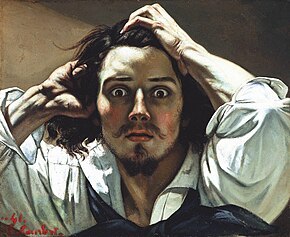
Gustave Courbet, Le Désespéré, 1843-1845, Romanticism, oil on canvas, Private Collection.

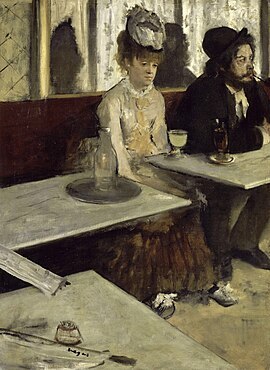
Edgar Degas, L'Absinthe, 1875-76, Impressionism, oil on canvas, Musée d'Orsay, Paris.


Edvard Munch, The Scream, 1893, Proto-Expressionism, oil, tempera, pastel and crayon on cardboard, National Museum and Munch Museum, Oslo.
Bonus: I literally couldn't find the reference to the original work for the life of me, someone PLEASE enlighten me if they know which work this is!

9 notes
·
View notes
Text
"Scholars often dismiss physique references to ancient Greece as a mere ruse or rhetorical framework--a "classical alibi" or "discourse of validation"--to avoid censorship. But an examination of the lives of the founders, contributors, and members of the [physique studio and pictorial] Grecian Guild [1955-1968] tells a different story. The Grecian Guild was instrumental in helping a community of men struggling to find a discourse to explain and valorize their sense of themselves, particularly men outside of urban gay enclaves. Benson and Bullock [the founders of the Grecian Guild] took a discourse about ancient Greece that gay men had been using for nearly a hundred years and gave it mass distribution. They used it like gay men used reference to "the Greeks" or Mary Renault novels--as a way to signal their homosexuality. It was a rallying cry that brought in customers and helped them imagine a better world. As historian and biographer Benjamin Wise argues about the way Alexander Percy used the language of Hellenism, it was "a way of speaking out and covering up at the same time."
Invoking classical traditions in order to make an argument for gay rights has been largely forgotten in the twenty-first century, as such a line of argumentation has become politically and historiographically problematic. Indeed, much of modern LGBT historical scholarship and queer theory has asserted that a homosexual identity is a creation of a modern, capitalist world--that homosexual behavior in ancient cultures was understood in very different terms from the way it is today. Invoking classical antiquity also smacks of a Western bias that privileges European ancestry over other cultural and historical influences. Such arguments also raise the specter of pederasty and pedophilia--or at least age-discordant relationships--that play into the hands of gay rights opponents who relentlessly use the argument that gays recruit children to fight gay rights measures...
Despite these changes in cultural understandings and sensibilities, the use of the classical Greek trope to name gay organizations, periodicals, and commercial ventures continued for decades, even when the need for an alibi had eroded if not disappeared. The lambda or lowercase Greek "L" became one of the primary symbols of the 1970s gay liberation movement. During this same period Seattle's largest gay organization was the Dorian Group, and a Jacksonville, Florida-based gay magazine called itself David--a reference to Michelangelo's Renaissance statue--an indirect link to the classical tradition. Like the Grecian Guild, David offered membership in a fraternal organization with features such as a book club, a travel service, conventions, and even legal aid. As an online website, it continues to serve as one of Atlanta's premier LGBT news and entertainment sources.
...
While severely limited by the forces of censorship, the desire to create opportunities for customers to correspond, meet, and get acquainted attests to the palpable wish of gay men to connect with each other during this period. If few members attended a Grecian Guild convention, the possibility of doing so resonated widely. As a teenage Grecian Guild subscriber in Pawtucket, Rhode Island, Michael Denneny read the articles so carefully that he underlined the important parts. "That was proto-political organization, the agenda was very clear to me, and I think to everybody else who joined," Denneny remembered..."These magazines were really important to me," Denneny recalled. "They brought this whole possible world into being, which I'm not sure I could have visualized otherwise."
David K. Johnson, Buying Gay: How Physique Entrepreneurs Sparked a Movement
#queer history#thinking about aang and zuko's connection to the deep past#aang's strange displacement from his people and history#that means he has this distinct lived connection to a by-gone civilization and idyll#and then zuko's obsession with the air nomads#going to all their temples#and in the natla collecting all the nomad and avatar relics#then later their exploration of the sun warrior past#another ancient civilization whose philosophies they seek to adapt#and how both of these relate to aang and zuko's exploration of their gender and alternatives to contemporary masculinity#these fascinations with lost civilizations bring aang and zuko together too#and even force them to address assumptions about age-differences...#just a lot to unpack#just about how exploring other cultures and history thoroughly dislodges one's construction of reality#and opens up possibility
14 notes
·
View notes